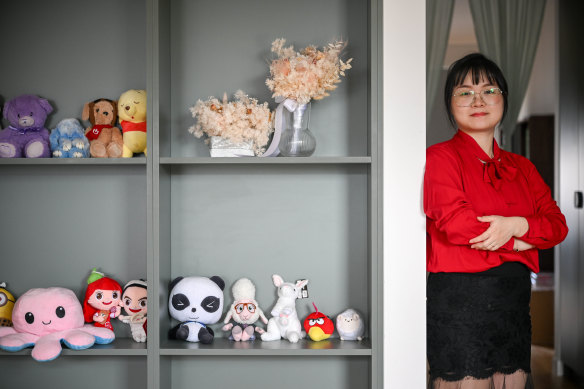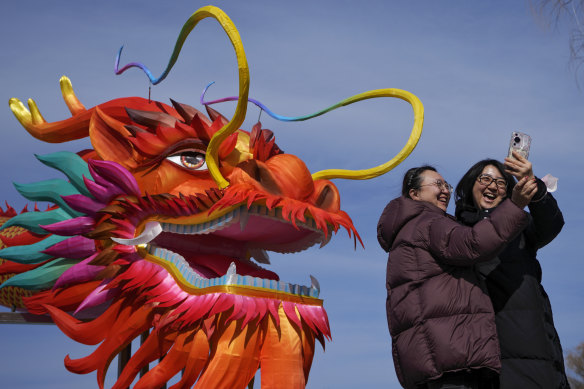This was published 9 months ago
‘I’ll try for the dragon’: Why Chinese births are expected to spike this year
Monash IVF obstetrician and fertility specialist Dr Jinny Foo received an urgent request for an appointment last month.
Her patient Jane Xia – who had originally planned to have a second child in 2025 – had suddenly realised the significance of the new lunar year, which starts on February 10.

“The dragon represents positive qualities such as power, strength, good luck and wisdom”: IVF specialist Dr Jinny Foo.Credit: Rhett Wyman
“When I looked up the Zodiac, I realised oh, it’s a dragon this year,” Xia says.
“I went, oh my gosh, I’ll have to try for the dragon! In Chinese culture the dragon is always a symbol of greatness. Most parents want their child to have a little bit of that greatness. That’s probably why a lot of us aim for the dragons.”
Many Chinese people regard the dragon – the only mythical creature in the Chinese zodiac – to be the most auspicious sign in the 12-year cycle. Children born under the sign are believed to be destined for good fortune.
In recent dragon years, China, Hong Kong, Taiwan and countries which have a large ethnic Chinese populations such as Singapore have experienced baby booms.
Foo, who grew up in Singapore, recalls her mother explaining to her that extra school places had to be added at Singapore schools to cater for the larger dragon year cohorts.
“The dragon represents positive qualities such as power, strength, good luck and wisdom,” says Foo, who has received a few desperate emails from patients wanting appointments at her Parramatta clinic. The IVF specialist is doing all she can to help bring about the birth of little dragons.
“I understand where they’re coming from but the problem with the Year of the Dragon is limited time. At the end of the day, whatever year you are born in, you make good. I think it’s more important to have a baby when it suits you.”
The Year of the Dragon is followed by the Year of the Snake, which is considered by many a less desirable zodiac sign.
“If it was a bunny next year, I wouldn’t be so concerned,” Xia says. “If I was in China I wouldn’t be so concerned either because the snake is considered a little dragon. But in the Western culture the snake has kind of a negative connotation, like a snake in the grass.”
Xia has an egg transfer scheduled for later this month. “I’m definitely one of those patients who tried to get in to see Dr Foo before it’s too late.”
The Year of the Dragon ends on January 28, 2025, which means that women have until late April to conceive.
Melvis Miao, who became pregnant after her second round of IVF, had her fingers crossed for a dragon baby after missing out on a rabbit baby when her first IVF cycle failed.

Melvis Miao is delighted to be pregnant with a dragon baby.Credit: Eddie Jim
She says it was touch and go whether the timing of her cycle would mean she could have the egg transfer at Melbourne IVF before the Christmas break.
“I was hoping, hoping my body would listen to me and then it happened. Luckily I got my surgery scheduled on the last working day. I did have a strong feeling that this time it was going to work. When I heard the news – oh my god – it was so exciting.”
Miao’s fertility specialist, Dr Fleur Cattrall, has both Chinese and non-Chinese patients who have told her the Year of the Dragon was a lucky one.
“Everyone knows the Year of the Dragon,” she says. “When people are struggling to fall pregnant they often look for signs of good fortune and hope.”
During 2012, the most recent Year of the Dragon, Singapore’s birth rate skyrocketed to a five-year high.
A 2021 study that analysed births in the southern Chinese city of Shenzhen, found that 6.7 per cent were deliberately delayed from the last week of 2011’s Rabbit year to the first week of the 2012 Dragon year.
In 2012, China’s birth rate increased to 14.57 births per 1000 inhabitants – up from 13.27 in 2011 – before dipping back down to 13.03 in 2013.
Xiujian Peng, a senior research fellow from the Centre of Policy Studies at Victoria University, says there are hopes this dragon year will also see a bump in births, after China’s population shrunk for two consecutive years.

Women take a selfie with a giant dragon lantern in Beijing.Credit: AP
Demographer Daniel Goodkind, whose doctoral thesis was on the dragon baby boom, predicts a substantial birth spike this dragon year in ethnic Chinese populations across the world, including Australia.
However, Goodkind says it is a relatively modern phenomenon. Birth rates first spiked in the dragon year of 1976 in Taiwan, Hong Kong, Singapore and Malaysia.
Goodkind says this is likely to be because the lack of modern contraception made it harder to time births in the past.
The surge in fertility outside of mainland China in 1976 and 1988 could reflect ethnic Chinese communities reviving traditional symbols which were under threat during the Cultural Revolution, he says.
The dragon boom years led to perverse outcomes in some places, where dragon babies faced increased competition at school, for university places and in the labour market.
Goodkind says the 1976 fertility spike in Taiwan led to greater demands on maternal health services and overcrowded classrooms, prompting authorities to launch the “Think Three Times” campaign in an attempt to discourage parents from aiming for birth in the 1988 dragon year.
Get the day’s breaking news, entertainment ideas and a long read to enjoy. Sign up to receive our Evening Edition newsletter here.